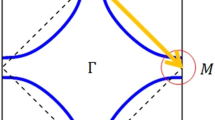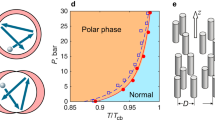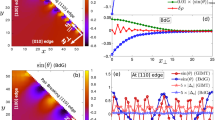Abstract
Strong correlations are central to the problem of high-temperature superconductivity in the cuprates1,2,3,4. Correlations are responsible for both the Mott insulating, antiferromagnetic state in the parent compounds and for the d-wave superconducting state that arises on doping with mobile charge carriers. An important experimental fact about the superconducting state is its insensitivity to disorder5, in marked contrast with conventional theories of d-wave pairing, which predict just the opposite. Here, we generalize the theory of the strongly correlated superconducting ground state based on projected wavefunctions6,7,8,9 to include impurity effects and find the remarkable result that correlations play a central role in making the superconductor robust against disorder. The nodal quasiparticles, which are the low-energy electronic excitations, are protected against disorder leading to characteristic signatures in scanning tunnelling spectroscopy10,11,12,13,14 and angle-resolved photoemission15,16,17.
This is a preview of subscription content, access via your institution
Access options
Subscribe to this journal
Receive 12 print issues and online access
$259.00 per year
only $21.58 per issue
Buy this article
- Purchase on SpringerLink
- Instant access to full article PDF
Prices may be subject to local taxes which are calculated during checkout



Similar content being viewed by others
References
Anderson, P. W. The resonating valence bond state in La2CuO4 and superconductivity. Science 235, 1196–1198 (1987).
Kotliar, G. & Liu, J. Superexchange mechanism and d-wave superconductivity. Phys. Rev. B 38, 5142–5145 (1988).
Anderson, P. W. et al. The physics behind high-temperature superconducting cuprates: The ‘plain vanilla’ version of RVB. J. Phys. Condens. Matter 16, R755–R769 (2004).
Lee, P. A., Nagaosa, N. & Wen, X. G. Doping a Mott insulator: Physics of high-temperature superconductivity. Rev. Mod. Phys. 78, 17–85 (2006).
Alloul, H., Bobroff, J., Gabay, M. & Hirschfeld, P. J. Defects in correlated metals and superconductors. Preprint at <http://arxiv.org/abs/0711.0877> (2007).
Zhang, F. C., Gros, C., Rice, T. M. & Shiba, H. A renormalised hamiltonian approach for a resonant valence bond wavefunction. Supercond. Sci. Technol. 1, 36–45 (1988).
Paramekanti, A., Randeria, M. & Trivedi, N. Projected wavefunctions and high temperature superconductivity. Phys. Rev. Lett. 87, 217002 (2001).
Paramekanti, A., Randeria, M. & Trivedi, N. High Tc superconductors: A variational theory of the superconducting state. Phys. Rev. B 70, 054504 (2004).
Edegger, B., Gros, C. & Muthukumar, V. N. Gutzwiller-RVB theory of high temperature superconductivity: Results from renormalised mean field theory and variational Monte Carlo calculations. Adv. Phys. 56, 927–1033 (2007).
Pan, S. H. et al. Microscopic electronic inhomogeneity in the high-Tc superconductor Bi2Sr2CaCu2O8+δ . Nature 413, 282–285 (2001).
McElroy, K. et al. Coincidence of checkerboard charge order and antinodal state decoherence in strongly underdoped superconducting Bi2Sr2CaCu2O8+δ . Phys. Rev. Lett. 94, 197005 (2005).
Vershinin, M. et al. Local ordering in the pseudogap state of the high-Tc superconductor Bi2Sr2CaCu2O8+δ . Science 303, 1995–1998 (2004).
McElroy, K. et al. Atomic-scale sources and mechanism of nanoscale electronic disorder in Bi2Sr2CaCu2O8+δ . Science 309, 1048–1052 (2005).
Pasupathy, A. N. et al. Electronic origin of the inhomogeneous pairing interaction in the high-Tc superconductor BiSrCaCuO. Science 320, 196–201 (2008).
Campuzano, J. C., Norman, M. R. & Randeria, M. in Physics of Superconductors Vol. II (eds Bennemann, K. H. & Ketterson, J. B.) 167–273 (Springer, Berlin, 2004).
Zhou, X. J. et al. Dichotomy between nodal and antinodal quasiparticles in underdoped (La2−xSrx)CuO4 superconductors. Phys. Rev. Lett. 92, 187001 (2004).
Shen, K. M. et al. Nodal quasiparticles and antinodal charge ordering in Ca2−xNaxCuO2Cl2 . Science 307, 901–904 (2005).
Abrikosov, A. A. & Gorkov, L. P. Theory of superconducting alloys with paramagnetic impurities. Sov. Phys. JETP 12, 1243 (1961); Zh. Eksp. Teor. Fiz. 39, 1781–1796 (1960).
Balatsky, A. V., Vekhter, I. & Zhu, J-X. Impurity-induced states in conventional and unconventional superconductors. Rev. Mod. Phys. 78, 373–433 (2006).
Mackenzie, A. P. & Maeno, Y. The superconductivity of Sr2RuO4 and the physics of spin-triplet pairing. Rev. Mod. Phys. 75, 657–712 (2003).
Atkinson, W. A., Hirschfeld, P. J. & MacDonald, A. H. Gap inhomogeneities and the density of states in disordered d-wave superconductors. Phys. Rev. Lett. 85, 3922–3925 (2000).
Ghosal, A., Randeria, M. & Trivedi, N. Spatial inhomogeneities in disordered d-wave superconductors. Phys. Rev. B 63, 020505 (2000).
Nunner, T. S., Andersen, B. M., Melikyan, A. & Hirschfeld, P. J. Dopant-modulated pair interaction in cuprate superconductors. Phys. Rev. Lett. 95, 177003 (2005).
Wang, Z., Engelbrecht, J. R., Wang, S., Ding, H. & Pan, S. H. Inhomogeneous d-wave superconducting state of a doped Mott insulator. Phys. Rev. B 65, 064509 (2002).
Wang, Q-H., Wang, Z. D., Chen, Y. & Zhang, F. C. Unrestricted renormalized mean field theory of strongly correlated electron systems. Phys. Rev. B 73, 092507 (2006).
Sensarma, R., Randeria, M. & Trivedi, N. Can one determine the underlying Fermi surface in the superconducting state of strongly correlated systems? Phys. Rev. Lett. 98, 027004 (2007).
Haas, S., Balatsky, A. V., Sigrist, M. & Rice, T. M. Extended gapless regions in disordered d x 2 − y 2 wave superconductors. Phys. Rev. B 56, 5108–5111 (1997).
Nachumi, B. et al. Muon spin relaxation studies of Zn-substitution effects in high-Tc cuprate superconductors. Phys. Rev. Lett. 77, 5421–5424 (1996).
Tsuchiura, H., Tanaka, Y., Ogata, M. & Kashiwaya, S. Quasiparticle properties around a nonmagnetic impurity in the superconducting state of the two-dimensional t–J model. J. Phys. Soc. Jpn. 68, 2510–2513 (1999).
Randeria, M., Sensarma, R., Trivedi, N. & Zhang, F. C. Particle–hole asymmetry in doped Mott insulators: Implications for tunneling and photoemission spectroscopies. Phys. Rev. Lett. 95, 137001 (2005).
Acknowledgements
We thank R. Sensarma for discussions and gratefully acknowledge support by NSF-DMR 0706203 (M.R.) and DOE DE-FG02-07ER46423 (N.T.).
Author information
Authors and Affiliations
Corresponding author
Rights and permissions
About this article
Cite this article
Garg, A., Randeria, M. & Trivedi, N. Strong correlations make high-temperature superconductors robust against disorder. Nature Phys 4, 762–765 (2008). https://doi.org/10.1038/nphys1026
Received:
Accepted:
Published:
Issue date:
DOI: https://doi.org/10.1038/nphys1026
This article is cited by
-
Origin of superconductivity in hole doped SrBiO3 bismuth oxide perovskite from parameter-free first-principles simulations
npj Computational Materials (2023)
-
Infinite-layer nickelates as Ni-eg Hund’s metals
npj Quantum Materials (2023)
-
The mixed-state entanglement in holographic p-wave superconductor model
Journal of High Energy Physics (2023)
-
Nitrogen vacancy centre-based diamond microscope for investigating quantum materials
Bulletin of Materials Science (2021)
-
Effect of impurity scattering on superconductivity in K2Cr3As3
Science China Physics, Mechanics & Astronomy (2016)



